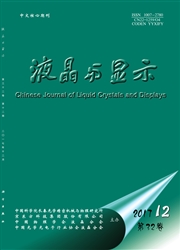

 中文摘要:
中文摘要:
利用射频磁控溅射法制备了不同衬底温度的氧化锌(ZnO)薄膜。研究了其场发射特性,分析了场发射特性和衬底温度的变化关系。实验结果表明,开启电场随着衬底温度的增加呈先增大后减小的趋势,场发射特性的变化是由于衬底温度的改变引起表面形貌的变化所致。衬底温度为300℃时沉积的ZnO薄膜样品粗糙度最小,场发射性能最差,其开启场强为1.7V/μm,场强为3.8V/μm时电流密度仅为0.00197A/cm^2;衬底温度为400℃时沉积的ZnO薄膜样品表面粗糙度最大,场发射特性也优于其他薄膜;开启场强为0.82V/μm,场强为3.8V/μm时电流密度稳定在0.03A/cmz^2 .Fowler-Nordheim(F-N)曲线为直线表明,电子是在外加电场的作用下隧穿表面势垒束缚发射到真空的。
 英文摘要:
英文摘要:
Zinc Oxide (ZnO) thin films were prepared by radio frequency (RF) magnetron sputtering. The field emission characteristics of the ZnO films were studied, and the relationship between the field emission characteristics and the substrate temperature of ZnO films was analyzed. The results showed that the turn-on field is increased then reduced with the substrate temperate increasing from 100 ℃ to 400 ℃. The reason results from the change of the surface morphologies which is due to the various of the substrate temperature. The surface roughness is the smallest and the field emission characteristics is the worst for the ZnO film deposited at a substrate temperature of 300 ℃, whose turn-on field is 1.7 V/μm and the field emission current density is only 0. 001 97 A/cm^2 when the applied field arrives at 3.8 V/μm. As for the ZnO film deposited at a substrate temperature of 400 ℃, the surface roughness is the biggest and the field emission characteristics is the best, whose turn-on field is 0.82 V/μm, the field emission current density arrived at 0.03 A/cm^2 when the applied field is 3.8 V/μm. The Fowler-Nordheim (F-N) curves are all nearly straight lines that indicate the electrons are emitted from ZnO films to vacuum tunneling by means of tunneling effect.
 同期刊论文项目
同期刊论文项目
 同项目期刊论文
同项目期刊论文
 Strain-induced Raman-mode shift in single-wall carbon nanotubes: Calculation of force constants from
Strain-induced Raman-mode shift in single-wall carbon nanotubes: Calculation of force constants from Enhancement of field emission of the ZnO film by the reduced work function and the increased conduct
Enhancement of field emission of the ZnO film by the reduced work function and the increased conduct 期刊信息
期刊信息
